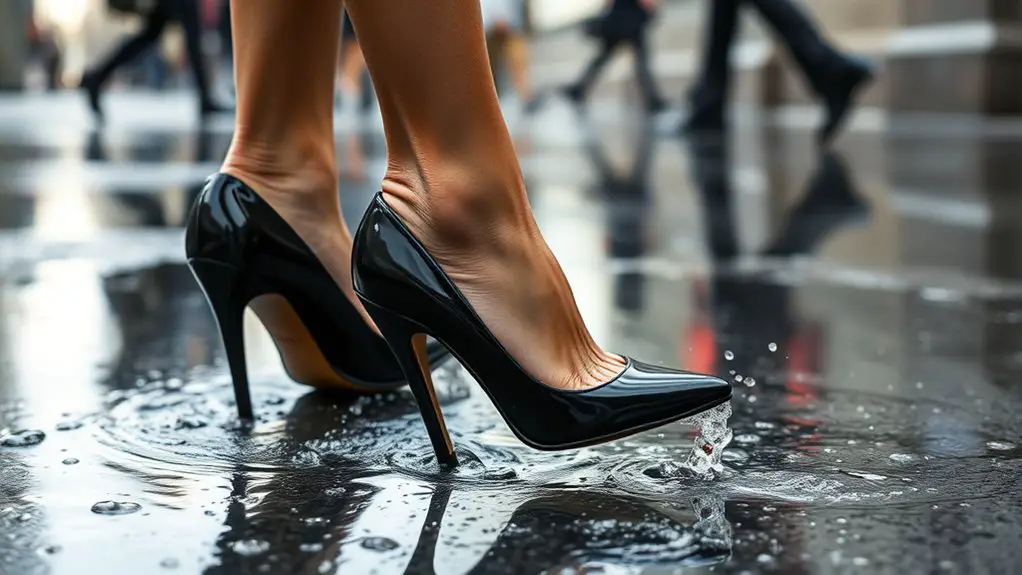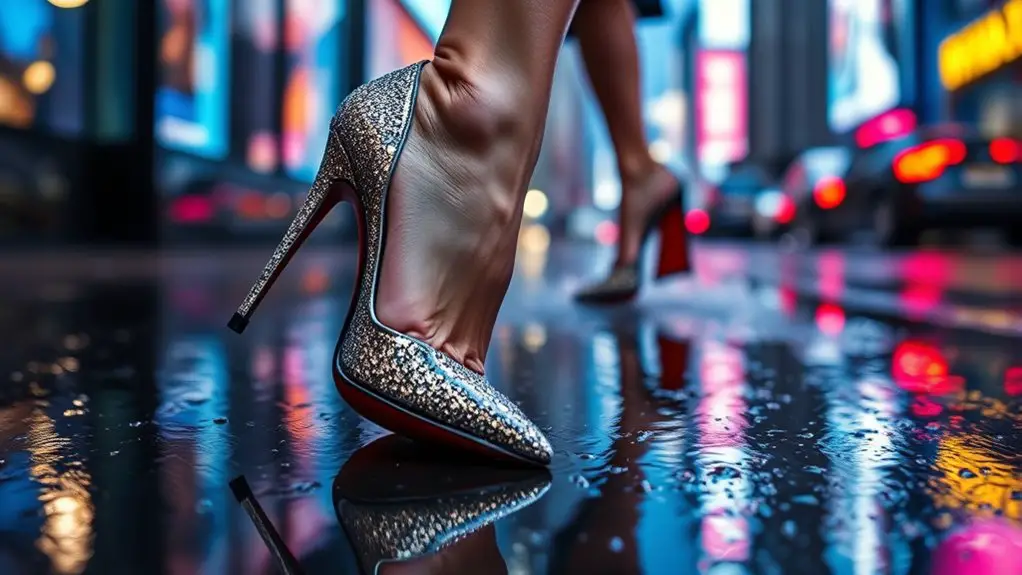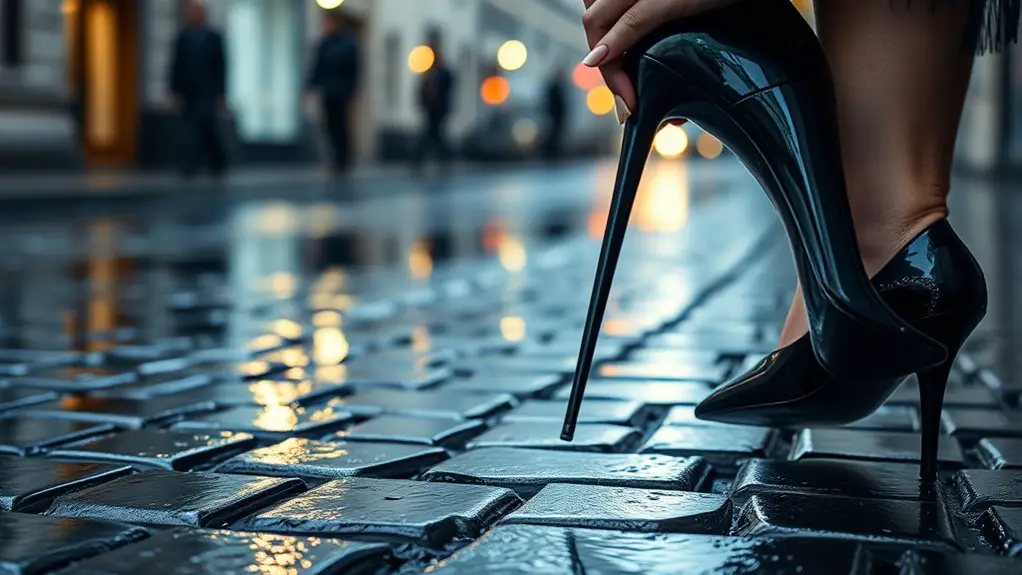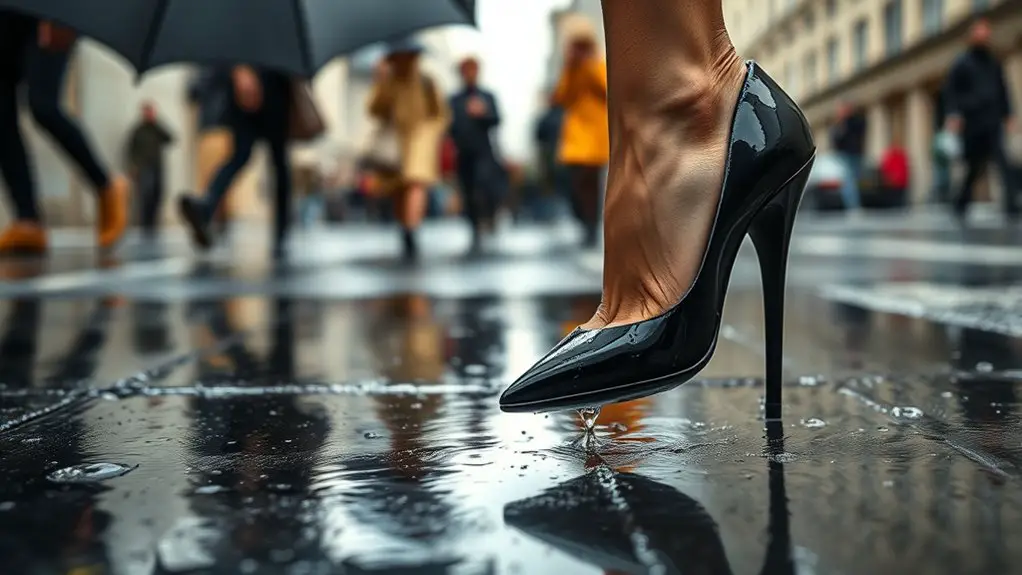Wearing high heels in wet conditions can be particularly dangerous. The reduced surface area in contact with the ground lowers friction, while the slippery surface increases your risk of slipping. Additionally, the design of high heels shifts your center of gravity, making you less stable. This combination heightens the chance of ankle sprains, falls, and serious injuries. If you want to discover effective ways to enhance your safety, continue exploring tips and alternative footwear options.
The Physics of High Heels and Slippery Surfaces

When you step onto a wet surface while wearing high heels, you’re not just maneuvering a fashion choice; you’re engaging with the principles of physics at play. The dynamics of friction become critical in this scenario. High heels, particularly those with greater heel height, considerably reduce the surface area in contact with the ground, which affects friction dynamics.
On a wet surface, the coefficient of friction decreases, leading to a higher likelihood of slipping. The taller the heel, the more pronounced this effect becomes, as the center of gravity shifts and stability decreases. Fundamentally, the combination of reduced contact area and slippery conditions can create a precarious situation. Understanding these physics principles can help you make informed choices about footwear in varying weather conditions and highlight the importance of selecting appropriate shoes for safety.
Common Injuries Associated With High Heels
Although high heels can elevate your style, they also come with a range of potential injuries that can affect your feet and overall well-being. Wearing high heels increases the risk of ankle sprains and balance issues, especially on slippery surfaces. If you’re not careful, slip accidents can lead to severe toe injuries or even foot fractures. Heel breaks are another common concern, particularly if the heel is not adequately supported.
Additionally, prolonged use can cause joint pain and skin abrasions from friction against the shoe’s interior. The unnatural positioning of your foot can exacerbate these issues, leading to chronic discomfort. It’s important to recognize these risks when choosing to wear high heels, particularly in wet conditions where the likelihood of accidents is heightened. Prioritizing your safety over fashion may save you from painful consequences down the line.
Fashion vs. Function: The Dilemma of High Heels

When choosing high heels, you often face the challenge of balancing style with safety. While elegant heels can elevate your outfit, they may compromise stability, especially in wet conditions. It’s crucial to contemplate weather-appropriate footwear choices that can maintain both your fashion sense and your well-being.
Style Over Safety
While the allure of high heels can be undeniable, especially in a world that often prioritizes aesthetics over practicality, the reality of traversing wet conditions raises significant concerns about safety. When you choose high heels, you often weigh your fashion priorities against the inherent safety concerns that come with them. The sleek design and height may elevate your outfit, but they can also compromise your stability on slick surfaces. Aesthetically pleasing shoes can lead to slips and falls, especially in rainy weather. You might find yourself torn between maintaining a stylish appearance and ensuring your well-being. Ultimately, it’s essential to recognize that prioritizing style over safety can have serious consequences, making informed choices necessary for both fashion and functionality in your footwear.
Stability vs. Elegance
The choice between stability and elegance in high heels often presents a challenging dilemma for fashion-conscious individuals. When selecting high heels, you must consider heel design and how it impacts your overall stability. While stilettos may offer a sleek appearance, they often compromise balance, making it harder to navigate wet surfaces. On the other hand, block heels or wedges provide better support and traction, which can enhance your balance strategies. However, they may not always exude the same level of sophistication as their slimmer counterparts. Finding the right pair involves weighing the importance of aesthetic appeal against practical functionality, ultimately guiding you toward a choice that balances both elegance and safety in your footwear.
Weather-Appropriate Footwear Choices
Steering through the challenges of choosing high heels becomes even more complex with changing weather conditions. Understanding how different footwear materials respond to various weather patterns is crucial for your safety and style.
| Weather Condition | Recommended Footwear Materials |
|---|---|
| Rainy | Rubber, Waterproof Leather |
| Snowy | Insulated, Non-Slip Materials |
| Hot & Humid | Breathable Fabrics, Canvas |
| Windy | Sturdy Soles, Ankle Support |
High heels, while fashionable, often lack the traction and support needed in adverse conditions. Opting for weather-appropriate choices not only enhances your comfort but also minimizes the risks associated with slips and falls. Balancing style with practicality guarantees you remain safe while looking your best, regardless of the weather.
Tips for Staying Safe While Wearing High Heels in Wet Weather

When wearing high heels in wet weather, choosing the right material can greatly impact your safety. Opting for non-slip soles will also enhance your grip on slippery surfaces. By making these informed choices, you can reduce the risk of accidents while maintaining your style.
Choose the Right Material
Choosing the right material for your high heels is essential for maintaining safety and comfort in wet conditions. Certain material types, like rubber or synthetic blends, can provide better traction compared to traditional leather. Rubber, for instance, offers natural grip enhancement, reducing the likelihood of slipping on wet surfaces. Additionally, consider water-resistant materials that can withstand moisture without compromising the shoe’s structure. While style is important, prioritizing functionality will help prevent accidents. Avoid materials that absorb water or become slippery when wet, as these can increase your risk of falls. By selecting appropriate materials, you not only enhance your safety but also extend the lifespan of your footwear in challenging weather conditions.
Opt for Non-Slip Soles
Selecting the right material for your high heels sets the foundation for safety in wet conditions, but the soles of your shoes play a significant role in preventing slips and falls. Opting for non-slip soles equipped with advanced non-slip technologies can greatly enhance your stability on slick surfaces. Look for shoes made from rubber or specially designed synthetic materials, as these provide better traction compared to traditional leather soles. Additionally, some brands incorporate textured patterns or grooves in their sole designs to further improve grip. When shopping, prioritize these shoe materials that cater to wet weather conditions, ensuring you can navigate your environment confidently without compromising style. Investing in non-slip soles is essential for maintaining safety while enjoying high heels.
Alternative Footwear Options for Rainy Days
Although high heels can elevate your style, they often falter in wet conditions, making alternative footwear options crucial for rainy days. Choosing the right shoes can keep you safe and stylish, so consider these rainy day alternatives:
- Waterproof Ankle Boots: These provide excellent traction and keep your feet dry while complementing various outfits.
- Stylish Rain Sneakers: Many brands offer fashionable waterproof sneakers that combine comfort and trendiness.
- Rubber Loafers: A chic option that’s easy to slip on and off, perfect for both casual and professional settings.
- Galoshes: These can be worn over your regular shoes for added protection without sacrificing style.
Selecting these stylish waterproofs guarantees you stay fashionable and safe even when the weather isn’t cooperating. By investing in quality alternatives, you can navigate rainy days with confidence and ease.
Personal Stories: Real-Life Experiences With High Heels in Wet Conditions
When it comes to high heels and wet conditions, many have had their fair share of mishaps. Your experiences may resonate with countless slip stories that highlight the risks involved. Here’s a breakdown of common heel mishaps:
| Incident Type | Description | Result |
|---|---|---|
| Slip on Pavement | Foot lost traction on a wet surface | Twisted ankle |
| Stuck in Grate | Heel caught in a drainage grate | Fall and embarrassment |
| Wobbly Steps | Uneven surfaces lead to instability | Minor bruises |
| Heel Breakage | Sudden pressure on wet ground | Ruined shoe |
| Splash Zone | Water splashing on heels | Soaked feet |
Each of these scenarios serves as a reminder of the precarious balance between style and safety. If you’ve ever faced a similar situation, you know just how quickly elegance can turn into a slippery disaster.
Frequently Asked Questions
Do High Heels Affect Balance in Wet Weather?
Maneuvering wet surfaces in high heels is like walking a tightrope; you face significant balance challenges. The unpredictable weather conditions amplify risks, making it essential to reflect on your footwear choice for stability and safety.
Can Heel Height Influence Slip Risk?
Yes, heel height can influence slip risk. Higher heels often compromise stability, while heel design and traction technology greatly impact grip. Choosing shoes with appropriate heel height and advanced traction can enhance safety in slippery conditions.
Are Certain Materials Safer for Wet Conditions?
When considering wet conditions, water-resistant materials and traction-enhancing designs can greatly improve safety. You’ll find that certain fabrics and sole technologies better grip surfaces, reducing slip risk and enhancing your confidence while walking.
How Do Different Heel Shapes Impact Stability?
Different heel shapes influence stability factors considerably. A broader base generally offers better support, while stilettos can compromise balance. Understanding heel design is essential for making informed choices that enhance both style and safety during wear.
What Are the Best Brands for High Heels in Rain?
When you’re searching for high heels suitable for rain, look for brands with waterproof features and traction soles. Ironically, you’ll find elegance in practicality as they blend style with safety, ensuring you stay stable and chic.



